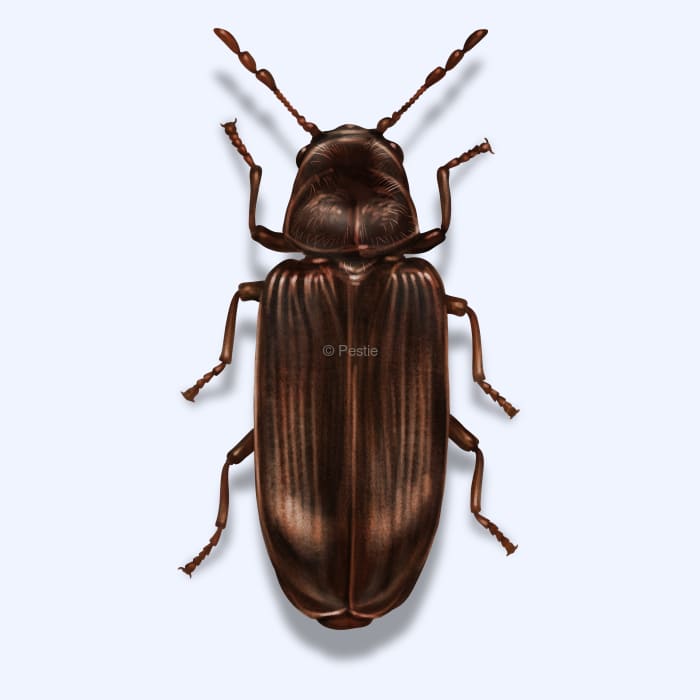How to identify and get rid of wood-boring beetles

Knock on wood: keeping anobiid beetles away
There are lots of insects that like to live in and eat wood. Many are beetles that bore tunnels into new, old, and rotten wood. Many of these beetles can't tell the difference between an old tree in the forest and an old timber in your home. And, if that timber is slightly moist and rotten, all the better.
Wood-boring beetles come in all shapes and sizes, but two species that can cause significant damage to older buildings and furniture are the deathwatch beetle and the furniture beetle.
Both of these species are in the subfamily Anobiinae and are commonly referred to as anobiid beetles. These beetles lay their eggs in cracks and crevices within wood, and once hatched, the larvae bore deeper into the wood, feeding on it and creating intricate galleries as they grow.
This larval stage can last several years, depending on the moisture content of the wood and the surrounding temperature, which can speed up their development. These beetles prefer damp wood, often caused by poor ventilation and leaky plumbing. That's why most infestations happen in older homes. Over time, if left unchecked, anobiid beetle infestations can compromise the structural integrity of the wood, leading to costly repairs and restorations.
The trouble begins when you hear a subtle yet persistent crunching sound within the walls or notice fine, powdery dust near wooden furniture and structural beams. Early detection and intervention are key to preventing these beetles from turning your cherished home into their feeding ground.
How to identify wood-boring beetles
Anobiid beetles are best known for their monk-like cowl that covers their head. It's an extension of their middle section, or thorax, covering their downward-facing head.
Their body is cylindrical, with grooves and puncture marks running down their elytra or wing covers.
Additionally, look for fine, powdery wood dust around furniture or beams, small exit holes in wood surfaces, and a subtle but audible crunching noise in infested wood. Deathwatch beetles also make a tapping noise as they hit their head on wood.
How big are wood-boring beetles?
They range in size from 1/16 inch to 3/8 inch long.
What other pest looks like wood-boring beetles?
They can be confused with tiny grain beetles that infest stored food or pantries. You might also mix them with other wood-eating beetles, like lyctid and bostrichid beetles.
Where do wood-boring beetles live?
Wood-boring beetles are widespread across the United States, especially in humid areas. They can be found in basements, crawlspaces, and attics inside the home. They will be in old beams, posts, or furniture.
How to get rid of wood-boring beetles
Once wood-boring beetles are infested into a piece of wood, removing or killing them can be near impossible. The best strategies are to control adults, reduce ideal conditions for the beetles, or protect your wood timbers and furniture. Unfortunately, wood-boring beetles can use the same resource year after year and can live in a piece of wood for up to ten years!
Here are a few steps you can take for prevention:
- Control Humidity: Use dehumidifiers and ensure good ventilation to reduce indoor humidity.
- Remove Infested Wood: Replace heavily infested wood to prevent the spread of the beetles.
- Regular Inspection: Check vulnerable areas regularly for signs of infestation and address issues promptly. Check for any leaky pipes or rotten timbers in your home.
- Seal entry points: Seal up any openings, cracks, or gaps where beetles can access timbers or wood.
Treat wood-boring-beetles with Pestie
If you're still having trouble keeping wood-boring-beetles away, the best option is to use a pro-grade, effective pest control solution like Pestie.
Pestie is a do-it-yourself pest control solution that's specially designed to keep wood-boring-beetles and other pests away from your home.
With Pestie, you can rest easy knowing that your living space is protected and free of creepy crawlies. And the best part? It's designed for people, pets, and the planet, so you can say goodbye to harsh chemicals and hello to peace of mind!
- Save hundreds compared to traditional annual pest plans
- People, pet, and planet-friendly
- Pro-grade customized formulas
Quick facts
- Scientific name
Order - Coleoptera
- Colors
Transparent
- Life span
5-13 days
- Diet
Vegetable and ornamental plants
How dangerous are Wood-Boring-Beetles?
Low danger risk
Broad mites aren’t dangerous to people, pets, or structures.
Females can lay 5 eggs a day but only live for a few weeks. Even so, populations can rapidly explode if left unchecked.








